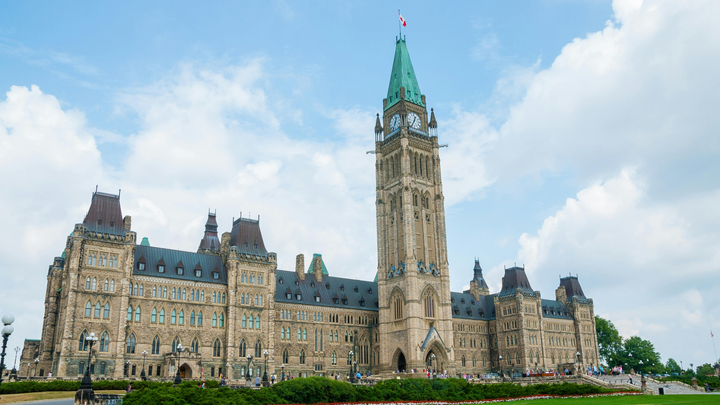Play it Again, CERB
The media continues to manufacture a public outcry over CERB payments

The tumultuous and traumatizing events that began in 2020 may seem like centuries ago to our decimated mental capacity, but their effects are still being felt. The pandemic, police brutality, rising fascism and the exhausting culture wars are worse than they’ve ever been since the days of “we’re all in this together.” More specifically, in the case of Canada, people who received the Canadian Emergency Response Benefit (CERB) have routinely and consistently been shamed by the media for taking payments needed to survive a deadly pandemic.
CERB payments have been a favourite target from neoliberal figures and institutions since their implementation. The Canadian media is no different in this regard. CERB was rolled out to protect laid-off earners who made more than $5000 a year and the rumblings of blame began almost immediately. In April 2020, the Financial Post plastered the back-handed compliment of a headline “'So easy I thought it was fake': CRA’s CERB system gets stellar reviews in first days of operation.” In May, the National Post raised alarms about the government ignoring “cheating” in applications to the program. The article cited “experts” from the Taxpayers Federation of Canada and the Institute of Fiscal Studies and Democracy, a think tank based out of the University of Ottawa. These two figures and the National Post were very concerned about the government’s fiscal responsibility.
Lest we forget the CBC piece that claimed CERB was being used to buy drugs, and led to a spike in overdoses. Their sources? A CEO, some care workers, and an executive director for the Main Street Project who literally said “I don't have data or statistics to tell you from here, but I think it is a logical connection.” Just… stunning reporting.
While these examples display a clear ideological bias, there is some merit in critiquing the Canadian government’s ramming through of CERB, and how they didn’t effectively communicate terms to applicants. In fact, as The Globe and Mail reported, almost two million Canadians need to repay CERB in some form even though they followed every direction given to them.
“…Ottawa distributed a $2,000 ‘advance’ payment to many who applied for the benefit through Service Canada before June 14, 2020. The funds… represented a four-week advance of future payments and were an effort to get money into people’s pockets as quickly as possible… But for those who were not entitled or did not collect payments for a period of at least 20 weeks, some or all of the advance is now an outstanding balance owing, according to ESDC.”
That’s right, if you were laid off due to the pandemic and returned to work as soon as you were able, you need to repay a portion of CERB. (Full disclosure: I was a recipient of CERB after being laid off from a cafe job. I returned as soon as it was offered and therefore fall into this category.)
Yes, critiquing the delivery of CERB and the repayment methods thrust upon its recipients, who applied in an unprecedented global pandemic, is more than fair game. Unfortunately for us, our media is owned by capital-focused business interests and as such their critique largely associates recipients with unsavoury elements.
The urgency of the COVID pandemic in 2020 mostly kept this particular brand of coverage to a minimum. But it’s now clear that these reports were just laying the ground work. “More than $636M in CERB benefits paid to 300,000 teens aged 15 to 17” the National Post cried in January 2021, quietly noting “the CERB program was available only to those over the age of 15.” “Where did $82 billion in CERB go?” investigated the CBC, noting the industry and class divides in recipients. CTV asked “How many Torontonians got it?” with a quizzical glance. This mixed bag had an underlying negative framing: Why does it matter how many Torontonians got it? Why are the financials of the stimulus program so important to highlight? This was just the next step of the coverage. The Financial Post even published an opinion piece laying the blame of confusing applications at the government, but the subheader “CERB recipients who acted in good faith” gives away the logical end point.
Before we knew it, most coverage of CERB focused more on the negative aspects of recipients rather than the implementation or demands of payment. Organized crime! People got double payments! Oh no, the Fraser Institute has a take on how CERB is bad! Look what hell we hath wrought!

Though the reporting may have covered serious abuses and failings by the government in this program, care was not taken to distinguish the expected bad actors from those who needed these payments to live. Sympathetic coverage in 2021 was lent primarily to applicants who were self-employed, as seen in the Toronto Star and CP24. Meanwhile, similar stories in 2022 read as patronizing. CTV coverage of repayments began their headline with the words “Not fair.” This almost begs to be responded with the thought-terminating cliche response of “Life’s not fair!” But at the same time, any applicant with foreign addresses must be heavily investigated.
The reason I’m penning this now is that this cultivated rage has once again been picked up in the press. With the latest auditor general report, the news media reported devastating figures. “$4.6 billion in financial aid went to ineligible recipients,” CTV reports. Meanwhile, BlogTO was aghast that “Canada paid out billions of dollars in CERB to people who lied about needing it.” Once again, CERB recipients are associated with fraud and greed, while the government’s confusing directions are paid less and less attention.
The CTV article in particular chooses an odd headline, burying the lede that’s far more interesting. Further down in the piece, they note
“The auditor general found that, in addition to the billions of dollars in overpayments, another estimated $27.4 billion in payments to individuals and employers should be ‘investigated further; for potential ineligibility, including $15.5 billion that went out through the wage subsidy program.”
The unnamed “wage subsidy program” in that paragraph is the Canadian Emergency Wage Subsidy (CEWS). One in which thousands of businesses that received payments may have also been ineligible. For keen readers, you may have noticed that 4.5 billion is less than 15.5 billion. It may seem odd the CTV article didn’t mention the CEWS by name, or that BlogTO does, while omitting the $15 billion figure. For those who have been tracking the media’s coverage of CERB, it’s the logical conclusion of their reporting. A more in-depth analysis of the latest media furor over CERB payments specifically was reported on Friday by independent journalist Jeremy Appel in The Orchard. In his piece, Appel addresses the attention paid by media outlets to business payments.
The CBC’s story, headlined, “Federal COVID-19 vaccine, benefits rollout swift but wasteful: AG,” mentioned the potential overpayments to businesses in a single bullet point.
A 1,250-word Globe and Mail piece dedicates just one-and-a-half paragraphs, or 37 words, to the question of ineligible CEWS payments.
A Toronto Star story doesn’t mention the possibility of ineligible CEWS payments until its penultimate paragraph, but to its credit does question whether the government should expect individuals to pay back benefits that were applied for in good faith.
When this is the direction news media has broadly taken, the default conclusion assumes the recipients of the benefit should be the main focus. By extension, everyone who applied to CERB has been tainted by association with a bungling government, fraud, drug use, fiscal irresponsibility and organized crime. Businesses who received far larger payouts remain a side note. As Appel notes, the Netherlands’ similar program requires that businesses pay no bonuses or dividends, or stock buy backs with their wage subsidy. This was not a requirement for CEWS.
There are exceptions to this coverage, of course, as a unified front would simply be too suspect. One completely unexpected example is the Financial Post’s reporting. Their story reported the $9.87 billion in payments given to possibly ineligible businesses, also addressing the aforementioned $15 billion figure.
Businesses receiving ineligible payments, or the subsidies for them as a whole, simply don’t motivate the media to the same degree as CERB payments. This phenomenon can be observed while covering other business subsidy programs outside of CEWS, specifically. Ontario premier Doug Ford and his government gave $210 million in COVID support payments to businesses through provincial programs. The government simply didn’t attempt to retrieve the funds. This story was reported, then not followed up on. In addition, 52 per cent of businesses who received Albertan support were ineligible. Keep on eye on whether this fact remains a key feature in COVID payment coverage in the future.
Nora Loreto’s piece in Passage on the CERB/CEWS dynamic offers a more in-depth analysis of the way the programs were handled. Long story short, the transfer of public money to private wealth is the primary purpose of these initiatives. This is also the dynamic reflected in news media coverage on each program. Those who study and monitor news industry behaviour are aware that most misinformation comes from ideological framing and the context provided, rather than outright falsehoods. The connection between CERB and inappropriate recipients has been stoked ever since the CBC simply assumed that the money was used for drugs. Fuel has been added by the media ever since.
I’m currently halfway through Michael Parenti’s fantastic book Inventing Reality: The Politics of the News Media. It’s my personal belief that this and Manufacturing Consent by David S. Herman and Noam Chomsky should be required reading for every aspiring journalist or media critic. Nearly every page of each book delivers a revelation. In terms of which subjects are chosen for coverage by the news media, Parenti elaborates their role in crafting public perception.
“[E]ven more than manipulating actual opinions, the media have a great deal of power in controlling opinion visibility. They create a media image of public opinion that often plays a more crucial role in setting the issue agenda than does actual public opinion and which has a feedback effect on actual opinion.”
Taken as a whole, the news industry’s narrative on CERB and CEWS (or other provincial equivalents) is clear. CERB’s implementation was a mess, it invited corruption, greed and unnecessary fiscal headache. Applicants flooded to take advantage of the government’s gracious payments. Organized crime, drug use, teen irresponsibility and now fraud stains every recipient’s motivations. Some responsible entrepeneurs and managers were caught in the cross fire, and others who were affected complained that the system isn’t fair.
In contrast, CEWS was simply imperfect. No discussion of CEWS repayment is had. Instead, coverage simply describes “ineligibility” as the sole issue. Since “ineligibility” is the sole problem covered, “eligible” payments are assumed to be justified. Even so, those who were inelegible received nowhere close to the level of sustained reporting CERB recipients did. Which particular businesses or sectors exploited federal or provincial benefits are not investigated. The choice not to follow-up on these payments by respective governments receives little coverage past initial reporting. The funds from these programs hoarded by executives at the top mostly just receive a footnote, if any coverage at all.
The business interests of news media are reflected in their coverage on any topic. Their reporting on CERB compared to CEWS and other business subsidies illustrates this framing perfectly. The view of working class Canadians, who used the funds to survive the early months of the pandemic, don’t align with the news media’s class interests. If they did, we would receive far more coverage of the disproportionate funds given to businesses. Instead we’ve been bombarded with the message that CERB payments and recipients were the problem, rather than the transfer of wealth to private hands.
Author’s Note: The original version of this incorrectly referred to the Financial Post as the Financial Times. This has been corrected. We regret the error.




Comments ()